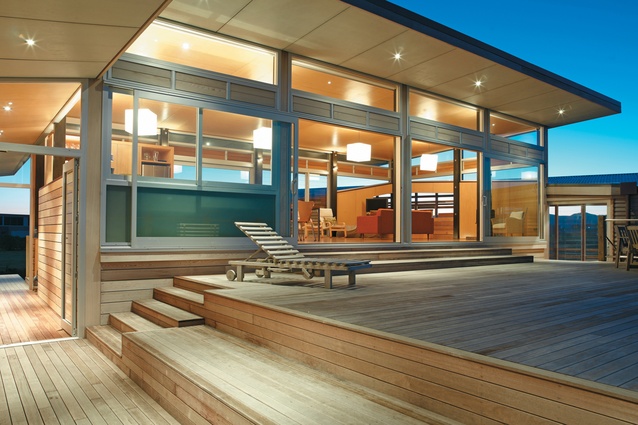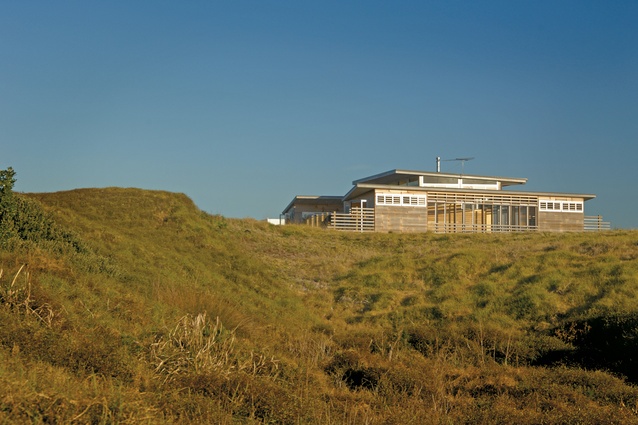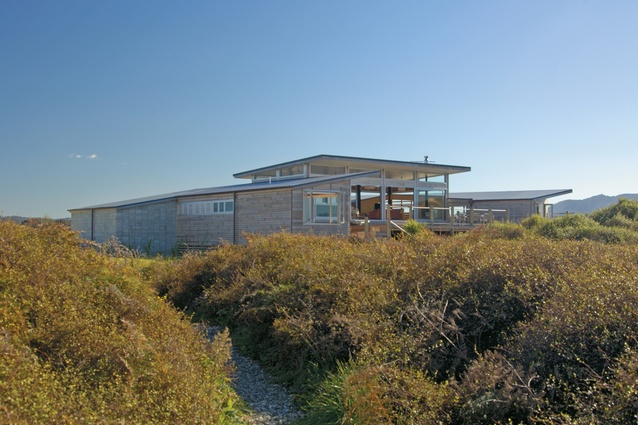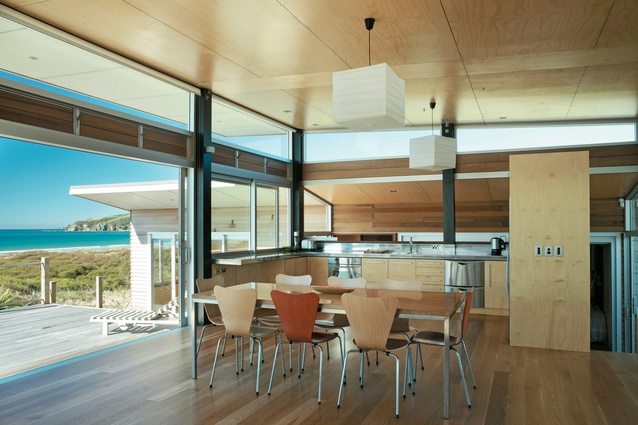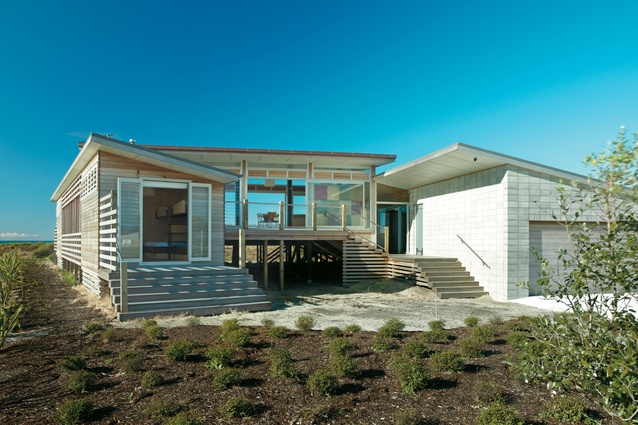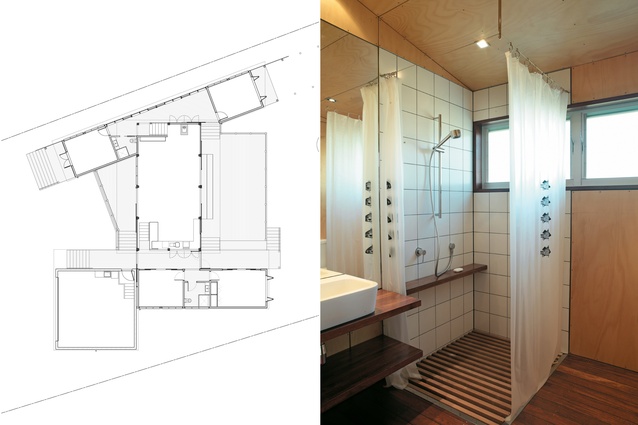Houses Revisited: Dune days
At ostentatious Omaha Aimer Naismith Architects have acknowledged the simpler bach tradition with the design of this home, first published in 2006.
Before the days of cheap air travel many families packed up their cars and trailers, and headed off to a beach to spend their Christmas holidays. It was a time when New Zealand’s accessible coastal areas were dotted with hardy little baches (and cribs) constructed of plywood, fibrolite and corrugated iron. Vacant during the winter, in summer these modest dwellings became crowded retreats for families prepared to share their holidays in an unfenced neighbourhood of caravans and tents.
The New Zealand coastal scene has changed, of course, not least in terms of monetary value. Beach houses – no longer ‘baches’ – now cost as much as homes in desirable inner city suburbs. Mike Dowsett, of Aimer Naismith Architects in Auckland, hadn’t designed a coastal property until a client decided to build on a newly purchased lot on South Omaha beach, an hour’s drive north of Auckland. A review of the clients’ brief called to mind that era when holiday homes were simple, and designed to withstand generations of family wear.
The clients, who have two young children, wanted a dwelling that would accommodate extended family and plenty of friends. It also had to be low-maintenance, secure enough to be shut up over the winter, and be built of materials that could take the knocks of beachside living. “[The clients] were very keen for the design to feel ‘bachy’ and not be too ostentatious,” says Dowsett. “It had to have a relaxed feel about it to match memories and expectations of childhood summer holidays.”
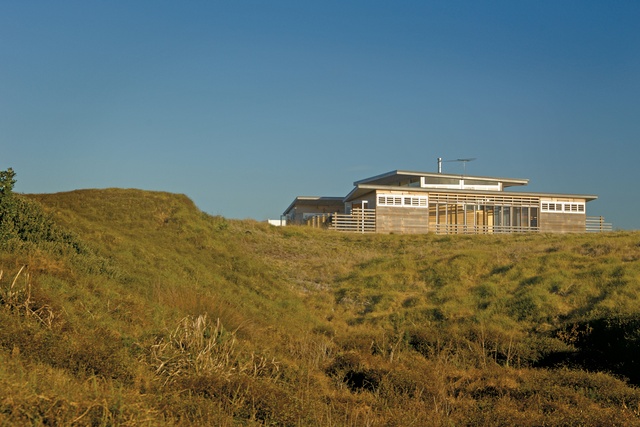
The section is in a prime location in the middle of crescent-shaped Omaha beach, separated from the sea by a narrow reserve of low sand dunes which are covered in native shrubs and grasses. The design concept had to accommodate a large dune in front of the house and a six-metre height restriction that protects the ocean views of properties to the rear. Dowsett says he could have squeezed a two-storey house design onto the site, but decided on a more discrete, single-storey dwelling which does, however, stretch across two levels. Echoing the shape of the dune, the house has a raised central pavilion (to maximize sea views), with accommodation extensions on either side.
“The bedroom wings are orientated to the view shafts each side of the dune in front, and provide protective arms sheltering the central outdoor space,” Dowsett says. “The wings also act as protection walls against future neighbouring dwellings on each side of the property, and a public path to the beach that runs down the northern boundary.” Three separate buildings, connected by decks (some enclosed), are intended to read as a reference to the Kiwi camping experience with tents and caravans grouped around a campsite.
Sitting at the end of a long driveway, the elevated house is anchored by a double garage of concrete and masonry that teasingly conceals any sea views from new arrivals. The pointing on the concrete blocking is impeccable – a small detail, but an early indication of the building quality that has gone into the overall construction. The entrance steps up to a fully enclosed deck, extending through to the dunes. This floor is the family accommodation wing, connected to the house by aluminium-framed windows and sliding doors, and to the elevated central living area through open spaces and an internal staircase. The wing has a master bedroom facing the sea through large bi-folding windows and separated from a children’s bedroom by a bathroom.
From the family wing and entrance deck you enter the central pavilion up a short flight of stairs. This generous living space is effectively a raised viewing area opened up, or closed down, to front and back decks through large sliding doors and glass louvre panels. An extensive front deck locks this centre structure with the two accommodation wings. It drops down a step towards a small strip of front lawn separating the house from the dune in front.
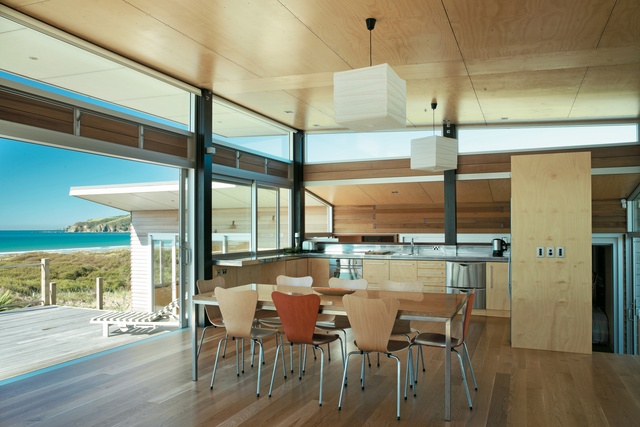
Internal walls, ceilings, and even the dining furniture, are made of varnished Australian hoop-pine veneered plywood panels. Trimming is in kwila. Again, Dowsett says, “We wanted to use materials that were hard wearing and didn’t need painting.” Held in place with visible screws in each corner, the plywood panels create a rustic look reminiscent of a fifties bach. “Sure, we could have nailed them, filled the holes and painted them for a finer finish,” Dowsett says, “but we didn’t want things to be demanding maintenance-wise later on.” The negative detailing between the panels is very accurate – a testimony to the quality of the builders, Dowsett says.
The interior is clean, bright and airy. Even the kitchen, with its stainless steel bench and plywood cupboard doors, has an unpretentious fifties feel. Floors are lined with American white oak that reflects light, as does the hoop pine. Anyone needing to escape summer glare can retreat to one of the wing rooms and close themselves off. The northern wing is also opened to the central living area; it is designed for guests with a rear bunkroom for kids, another double room, and a second bathroom. This wing has its own hot water system that can be shut down when not in use.
Within a year of being built, this beach home already had a well-settled look, its cedar weatherboards silvering in the face of coastal weather. Experiencing their first summer in their new bach, the owners extended their holidays and commuted to Auckland during the week for work. Already, there’s pressure on bed space, and Dowsett has been commissioned to design plans for another guest bedroom on top of the garage that will just squeeze under the height restriction. The decking, which features a fashionable outside fireplace in anticipation of extended summer stays, has also been extended to increase the outside entertainment area. There’s more space now for family and friends, and for those social evenings around the barbecue. Did anyone remember the playing cards and the Monopoly board?
Click here to see more Houses Revisited. And sign up to our email newsletters to receive Houses Revisited straight to your inbox.
Note: These are stories from our archives and, since the time of writing, some details may have changed including names, personnel of specific firms, registration status, etc.

